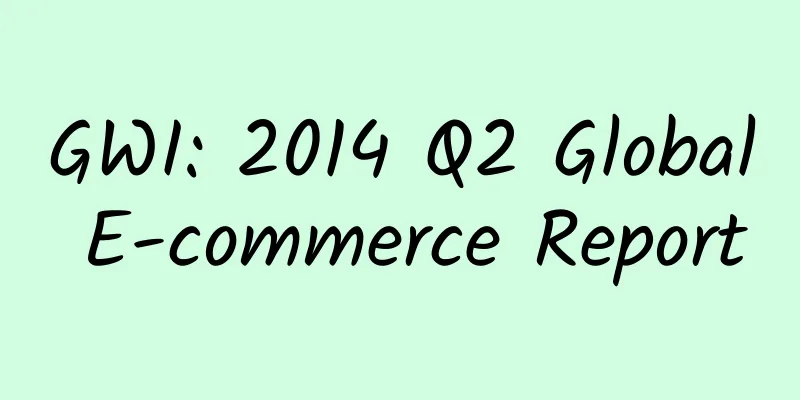GWI: 2014 Q2 Global E-commerce Report

|
199IT original compilation Report Introduction GWI Commerce is the latest online shopping and other commercial behavior index on different devices around the world provided by GlobalWebIndex. Every year, GWI interviews more than 170,000 netizens in 32 markets to study digital consumers. The report provides the following content:
Mobile and tablet e-commerce on the rise 66% of Internet users aged 16 to 24 shop online every month. Nearly one billion people use e-commerce in the 32 countries surveyed by GWI, up 52% from 2011, proving the vitality of e-commerce around the world. At this rate, this number will exceed 1.5 billion by 2018. Desktops and laptops are still the primary devices used for online shopping (57%), followed by mobile phones (26%) and tablets (12%). However, mobile phones and tablets have shown the fastest growth rates, increasing by 25% and 54% respectively since the end of 2012. Multi-device commerce has gone mainstream: more than a quarter of people shop online using both a desktop or laptop and a phone or tablet. Amazon and eBay global audience Amazon has global reach: just under 50% of global internet users aged 16 to 24 have visited the site in the last month. However, in terms of user numbers, more people visit from China each month than from the U.S. India, Brazil and Indonesia are also major markets for Amazon, a trend that is often overlooked because a large number of Internet users use virtual private networks or proxy servers. In the first quarter of 2014, 36% of Internet users aged 16 to 24 visited eBay, with Europe and North America having the highest visit rates at 47% and 44% respectively, but all regions surveyed had a visit rate higher than one quarter. The U.S. monthly visit rate (44%) lags behind countries such as Germany (73%), India (64%) and the UK (63%). China dominates all devices In China, 82% of Internet users aged 16 to 24 shop online every month, about 380 million people. In terms of the total number of audiences, China, the United States, India, Brazil, Indonesia, Germany, Japan, Russia, the United Kingdom and South Korea are in the top ten e-commerce markets. China leads across all devices: 76% of Internet users shop online via desktop or laptop, 60% use mobile phones, and 25% use tablets. In terms of desktop or laptop, mature internet countries besides China include Germany (69%), the UK (68%) and the US (62%). However, the situation is quite different with mobile phones, with the fastest growing countries showing more prominent performance (e.g., Turkey has 36% of people using mobile phones for shopping, Thailand has 35%, and Indonesia has 32%). Devices used for online shopping in different countries Along with “showrooming” (the internet-specific term for seeing products in stores and then searching online for the lowest price), clothes, shoes, gifts and books are the most popular online purchases. This trend is present in all GWI countries, but in the case of clothes, it is most prevalent in mature markets like Sweden, the UK, Germany and the US; and least so in countries like Turkey, the Philippines, the UAE, South Africa and Russia; Saudi Arabia is the only country without showrooming. Mobile is the most important tool for searching for products, reflecting the importance of “reverse showrooming” (where consumers first search, browse and research a product online before purchasing it in a physical store). This behavior is more common in mature markets, such as Japan, Canada and the United States. “Showrooming” is the most popular among young people, and the “anti-showrooming” orientation is directly consistent with age, indicating that the older group still has a certain resistance to online shopping compared to the younger group. Search engine usage increases with age When online consumers search for information about brands, products or services, search engines are the first choice. Globally, 56% of online consumers say they use search engines for research purposes, with this behavior highest in Germany at 72%, Sweden at 65% and Australia at 63%. The use of search engines increases with age. Only 53% of netizens aged 16 to 24 use search engines, while 63% of netizens aged 55 to 64 use search engines to research products. Internet users aged 16 to 24 use more resources such as blogs, applications, social network updates, videos, and content websites. In a sense, older consumers are obsessed with traditional search resources, while young people are more willing to use new channels. Download report: GWI_Commerce_Summary_Q2_2014 199IT original compilation Translator: Sun Ying |
<<: eMarketer: Twitter user base in the U.S. is beginning to mature
>>: eMarketer: Automation will be the next step in the evolution of email marketing
Recommend
What is the medicinal value of small-leaf red sandalwood?
Everyone knows about rosewood. Generally, we only...
The efficacy and function of Chongtian fruit
Many people choose Chongtian Fruit because of its...
Why are Capybaras so keen on rolling in the mud in the hot summer?
Yeah? Which two little guys are standing on the r...
Why is the upcoming Year of the Tiger only 355 days?
The upcoming Lunar Year of the Tiger From Februar...
Soil is alive! These bugs help plants grow
Produced by: Science Popularization China Author:...
These 5 types of people are more likely to get cancer! If you are in this situation, be sure to take precautions!
There are always people asking what kind of peopl...
The efficacy and function of large-leaf caesalpinia
As people's living standards improve, they pa...
Buffaloes "lie down" and refuse to plow the land? In fact, cows have two faces in private...
An Asian buffalo was plowing a field with its own...
Beware of "Autumn Sadness Syndrome"! Autumn is the peak season for depression and other "emotional illnesses"
Since the beginning of autumn, the number of pati...
Scientists make milk like beer. Will it make milk taste better?
People who pay attention to health know that drin...
The efficacy and function of Melu
The medical value of melon is beyond our imaginat...
The efficacy and function of rough-leaved tree
There are many kinds of common Chinese medicinal ...
What would happen if Schrödinger's fat cat became a reality?
Turning the famous idea of Schrödinger's ca...
Unexplained childhood hepatitis appears in many countries! What exactly is hepatitis?
Mixed Knowledge Specially designed to cure confus...
How long after drinking can you drive? These examples tell you the answer
I often have friends who drive When the police of...









